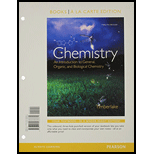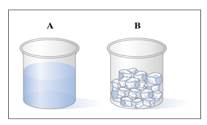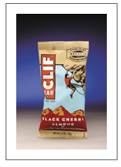
Concept explainers
Answer the following for water samples A and B Shown in diagrams: (3.1, 3.2, 3.3, 3.5)

a. In which sample (A or B) does the water have its own shape?
b. Which diagram (1 or 2 or 3) represents the arrangement of particles in water sample A?
c. Which diagram (1 or 2 or 3) represents arrangement of particles in water B?

Answer the following for diagrams 1, 2, and 3:
d. The
e. The motion of the particles is slowest in diagram .
f. The arrangement of particular is farther apart in diagram .
g. The particles fill the volume of the container in diagram .
h. If the water in diagram 2 has a mass of 19 g and a temperature of 45 °C, how much heat, in kilojoules, is removed to cool the liquid to 0 °C?

An energy bar contains carbohydrate, fat, and protein.
Want to see the full answer?
Check out a sample textbook solution
Chapter 3 Solutions
Chemistry: An Introduction to General, Organic, and Biological Chemistry, Books a la Carte Edition & Modified MasteringChemistry with Pearson eText -- ValuePack Access Card Package
- Calculate deltaH1 Please provide 3 sig figs, units are KJ/mol, please only give number value in answer. Mg(s) + 1/2O2(g) --> MgO(s) deltaH1 = ? Mg(s) + 2H+(aq) --> Mg2+(aq) + H2(g) deltaH2 = +10.1 kJ/mol MgO(s) + 2H+(aq) --> Mg2+(aq) + H2O(l) deltaH3 = -5.00 kJ/mol 1/2O2(g) + H2(g) --> H2O(l) deltaH4 = -286.0 KJ/molarrow_forwardThe recommended daily dose of calcium for an 18-year-old male is 1200 mg. If 1.0 cup of whole milk contains 290 mg of calcium and milk is his only source of calcium source, how much milk should an 18-year-old male drink each day in mL? Suppose the child is lactose intolerant, do some research and explain what type of milk would be a good substitute for the child. Please give mg of calcium per cup of alternative milk value, and show calculations for how much of the alternative milk an 18-year-old male should drink each day in mL. (Hint: 1 cup = 236.588 mL) Show all work. Give numerical answers in 2 significant figures.arrow_forwardCalculate the Ka of X in chloroform. Answèr in 4 significant figures.arrow_forward
- Mr. Naresh works in a multinational company. He is stressed due to his hectic schedule. Mr. Amit, his friend, comes to know that he has started taking sleeping pills without consulting the doctor. Mr. Amit requests ‘ Naresh to stop this practice and takes him to a Yoga centre. With regular Yoga sessions, Mr. Naresh is now a happy and relaxed man. ‘ After reading the above passage, answer the following questions: (i) Write the values shown by Mr. Amit. (ii) Which class of drugs is used in sleeping pills? (iii) Why is it not advisable to take sleeping pills without consultation with the doctor?arrow_forwardWhich of the following correctly describes the values of % AE and the E-factor for the reaction below? (% AE = percent atom economy; E-factor = environmental factor) pick one option 4 NH3 + 5 O2 → 4 NO + 6 H2O % AE < 100; E-factor = 0 % AE = 100; E-factor > 0 % AE = 100; E-factor = 0 % AE = 0; E-factor > 0 % AE = 0; E-factor = 0arrow_forwardAfter Maria’s 8th cup of coffee one night during finals week, she remembered that high doses of caffeine can kill you. Maria was worried that she was more susceptible because she weighed only 47.7 kg. Maria did some research and found that 150 mg/kg of caffeine was lethal and the coffee she was drinking is 0.04% m/v caffeine. How many cups of coffee could Maria drink before she would likely die?arrow_forward
- Which of the following correctly describes the values of % AE and the E-factor for the reaction below? (% AE = percent atom economy; E-factor = environmental factor) 3 CO + 7 H2 ⟶ C3H8 + 3 H2Oarrow_forwardAnalysis of product: Calculate the percent recovery based on the amount of tea originally used and a final mass of 0.20g of caffeine obtained. Compare this value against a literature search about the approximate caffeine content by percent in black tea. Given: the observed melting point of the product crystals is 230oC-235oC -10 tea bags (black tea, contains ~45mg caffeine/bag) -total mass is 21.10g of the loose black teaarrow_forwardGypsum is the hydrate of calcium sulfate, CaSO4 · 2 H2O. It is the primary material in sheet rock, used to make walls in houses. Calculate the percent water in the hydrate. Report your response to 3 significant figures and include % as the unit.arrow_forward
- Mass of beaker and milk= 65.922 g Mass of beaker= 45.347 g Mass of milk (g)? pH of milk= 8 Isoelectric point= 5 Mass of watch glass and casein= 28.438 g Mass of watch glass= 27.832 g Mass of casein (g)? Percent casein in milk?arrow_forwardConsider the following unbalanced reaction: XNO3 (aq) + CaCl2 (aq) -> XCl (s) + Ca(NO3)2 (aq) If 30.8 g of CaCl2 produced 79.6 g of XCl, determine the identity of X. Quantify your response.arrow_forward1.A student masses an unknown hydrate sample and finds there are 5.00g of hydrate. After dehydrating the sample in an oven for 1h, the sample has a mass of 3.00 g. How many moles of water were removed from the hydrate. use dimensional analysis. 2. a. What is the mass of anhydride for the student sample? ___________ g anhydride b. If the formula weight (molar mass) of the anhydride is 89.54g/mol, how many moles of anhydride are in the student sample? c. What is the ratio of moles of water to moles of anhydride? mol H2O . = _____________ mol anhydride d. What is the formula for the hydrate? Fill in the blank: X • ___ H2Oarrow_forward
 Principles of Modern ChemistryChemistryISBN:9781305079113Author:David W. Oxtoby, H. Pat Gillis, Laurie J. ButlerPublisher:Cengage Learning
Principles of Modern ChemistryChemistryISBN:9781305079113Author:David W. Oxtoby, H. Pat Gillis, Laurie J. ButlerPublisher:Cengage Learning

